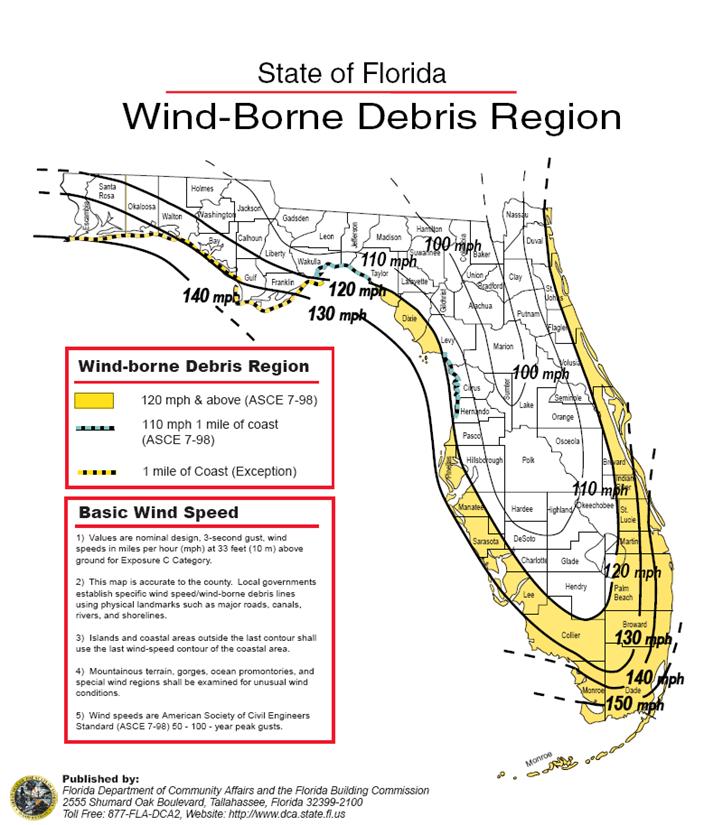|
Lessons Learned
On August 24, 1992, Hurricane Andrew slammed into south Florida. This devastating storm wrought over $25 billion in damage, leaving 43 people dead in its wake. Andrew’s catastrophic disaster recovery costs threatened to undermine property insurance companies doing business in the State of Florida. In the aftermath of Hurricane Andrew, the Florida Legislature created a series of tools to stabilize the economy and insurance industry in anticipation of future storms:
Insurance Industry Reorganization
Citizens Property Insurance Corporation was formed by a merger of the Florida Windstorm Underwriting Association and the Florida Residential Property and Casualty Joint Underwriting Association to provide coverage for residents unable to obtain a conventional homeowners insurance policy.
The Florida Hurricane Catastrophe Fund, a re-insurance fund, was established to limit insurance exposure after a storm.
Hurricane Preparedness
The Bill Williams Residential Safety and Preparedness Act created the “Hurricane Loss Mitigation Program”. The Legislature intended this program to direct funds for, “programs to improve the wind resistance of residences and mobile homes, including loans, subsidies, grants, demonstration projects, and direct assistance; cooperative programs with local governments and the federal government; and other efforts to prevent or reduce losses or reduce the costs of rebuilding after a disaster”.
This program is administered by the Florida Division of Emergency Management, with the input of the Residential Construction Mitigation Program (RCMP) Advisory Council. This program funds loss mitigation efforts for mobile homes, assistance to cover mitigation costs for lower-income homeowners, hurricane research, statewide mitigation planning, informing the public of wind mitigation issues, and post-storm rebuilding efforts. This program also funded the research necessary to develop the residential inspection program that now forms the basis for the My Safe Florida Home Program.
Building Code Revisions
In 1994, Miami-Dade County strengthened its building code to address a number of flaws that came to light after Hurricane Andrew. Shortly thereafter, Broward County also adopted the Miami-Dade revisions, creating the South Florida Building Code -- the most wind-resistant building code in the United States. In 2001, the state adopted a new, strengthened building code for the rest of the state – the Florida Building Code or FBC. This uniform code replaced more than 450 local building codes across the state. (Miami-Dade and Broward Counties continue to use the South Florida Building Code they enacted in 1994.)
Recent research indicates that improving the resiliency of the building stock located in hurricane-prone regions can markedly reduce loss and damage. In the aftermath of Hurricane Charley, post-disaster assessments indicated that insured losses for structures built under the 2001 Florida Building Code were as much as 40-50% lower than equivalent homes built to the previous building codes. Florida continues to fund research and testing of hurricane mitigation technologies that can be incorporated into future building code revisions. The state also participates in the Federal Alliance for Safe Homes and its “Blueprint for Safety” program, which encourages homebuilders to use mitigation techniques that exceed the minimum requirements of the Florida Building Code.
The new building codes adopted in 1994 and 2001 focus on new construction in Florida. In 2007, the legislature turned its attention to older homes. The legislature directed the Florida Building Commission to adopt standards for mitigation techniques for site-built, single-family, residential structures constructed prior to the implementation of the Florida Building Code. In particular, the law directed the Building Commission to find effective techniques to: ¨ brace gable end walls, ¨ add secondary water barriers for roofs, ¨ enhance roof-to-wall connections ¨ strengthen roof-decking attachments, and ¨ protect building openings such as windows and doors. The purpose of this directive is to develop cost-effective techniques homeowners can use to make their existing home more storm resistant. Homeowners can easily implement some of these improvements -- such as opening protection and gable-end wall bracing -- for relatively little cost without major reconstruction. Other upgrades are more complicated and costly. Reroofing presents an excellent opportunity for homeowners to tackle the more complicated and costly mitigation techniques. As a result, the Florida Building Code was amended in 2007 to require that all roof replacements in Florida strengthen the roof decking attachments and incorporate a secondary water barrier. (In addition, the law requires that roof replacements on single-family residential structures located in the wind-borne debris region* that have an insured value of $300,000 or more must also incorporate cost-effective improvements of roof-to-wall connection -- as long as such improvements do not add more than 15 percent to the cost of the reroofing). When filing a building permit for any new construction activity in Florida (including renovations of existing structures) with an estimated cost of $50,000 or more, the permit application must now include plans for protecting the structure’s openings, e.g., window shutters, wind resistant film, impact resistant doors, etc.
* The “wind-borne debris region” is, in general, where sustained winds of 120 mph or greater are likely to occur. (see map below)
|

|
< prev page 1 2 3 4 5 6 next page > |
